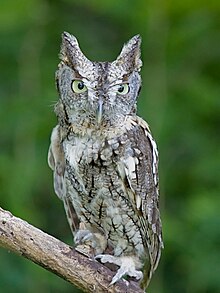Megascops
| Screech owl Temporal range: Miocene to present |
|
|---|---|
 |
|
|
Eastern screech owl, Megascops asio Rufous morph |
|
 |
|
| Gray morph | |
| Scientific classification | |
| Kingdom: | Animalia |
| Phylum: | Chordata |
| Class: | Aves |
| Order: | Strigiformes |
| Family: | Strigidae |
| Genus: |
Megascops Kaup, 1848 |
| Species | |
|
Some 20, see text |
|
| Synonyms | |
|
Gymnasio Carlo Bonaparte, 1854 |
|
Some 20, see text
Gymnasio Carlo Bonaparte, 1854
Macabra Carlo Bonaparte, 1854
Screech owls or screech-owls are typical owls (Strigidae) belonging to the genus Megascops. Twenty-one living species are known at present, but new ones are frequently recognized and unknown ones are still being discovered on a regular basis, especially in the Andes. For most of the 20th century, this genus was merged with the Old World scops owls in Otus, but nowadays it is again considered separate based on a range of behavioral, biogeographical, morphological and DNA sequence data.
Screech owls are restricted to the Americas. Some species formerly placed with them are nowadays considered more distinct (see below for details). The common name "screech owl" is sometimes used for the not closely related barn owl as well.
Similar to other owls, the screech owl females are larger than the males of their species. They have a compact size and shape. The screech owls are small and agile. They are about 7 to 10 inches tall and have a wingspan of about 18 to 24 inches. They have prominent, wide-set feather tufts with bright yellow eyes. They have different brownish hues with whitish, patterned underside. This coloration helps them get camouflage against the tree bark. They have well-developed raptorial claws and curved bill. They use them as a tool to tear their prey into pieces that are small enough for them to swallow. They tend to carry their prey to the nest and then eat it.
Screech owls hunt from perches in semi-open landscapes. They prefer areas which contain old trees with hollows; these are home to their prey which includes insects, reptiles, small mammals such as bats and mice and other small birds. Screech-owls have a good sense of hearing which helps them locate their prey in any habitat. They also possess well-developed raptorial claws and a curved bill, both of which are used for tearing their prey into pieces small enough to swallow easily. They usually carry their prey back to their nests, presumably to guard against the chance of losing their meal to a larger raptor.
...
Wikipedia
